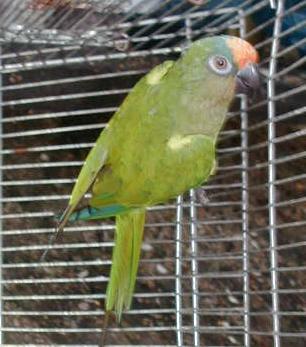Read my new book, The 10 Best Things You Can Do For Your Pet Bird, on almost any device:
right here.
It's real easy to contact me. Tweet or direct message me through Twitter by hitting this button:
Follow @PeachfrontGot a Peachfront, or thinking about getting a Peachfront? Here are some key posts you might like to read:
- How I Bred My Peachfronts
- Crazy About Conures, a reprint of one of my articles from American Cage-Bird Magazine, full of good stuff to help you care for your conure
- Peachfronts in the Wild
- How Long Do Peachfronts Live?
- Don't Go By Rumors: Peachfronts are NOT loud birds!
- What Sex Is My Bird?
Some recent entries you might enjoy:
happy 27th birthday to courtney - 2017-04-15
i no longer own the peachfront dot com domain - 2017-04-09
ronnie 1990-2017 - 2017-02-15
Ronnie and Sheldon try again - 2017-02-11
clear eggs 2017 - 2017-01-23
Even $1 buys several servings of mixed vegetables for my Peachfronts. Give my Peachfronts a gift by donating right here:
7:53 a.m. 2012-05-07
timmy's story, part one

� 2003 by Elaine Radford, all rights reserved
timmy shoftly after tropical storm bill in 2003
On Oct. 14, 1988, I purchased 3 adult peachfronted conures, imported from Bolivia. Along with the west coast of Peru, Bolivia might have been the last South American country to allow the legal export of birds at that time. The surgically sexed pair was $175, although it may not have been as much of a deal as it sounded at the time. The birds looked great, but the male died rather suddenly on May 25, 1989, of what was eventually determined to be "visceral gout" of an unknown cause. I suspect that the birds were older than I'd been led to believe. I had the female ("Morgana") checked by the vet to make sure that she was OK, and on July 30, 1990, I bought a surgically sexed male that I named Sheldon. He must have been young enough, because I still have this bird almost 22 years later.
Sheldon and Morgana, as untamed breeder birds, were kept in a large flight cage on the bird porch. They were so quiet and private that I have nicknamed them "the ghosts" in my notes of the time. In 1991, they hatched out their first baby, Beep, so they were not completely inexperienced parents in the 1992 breeding season. On May 9, 1992, they hatched out their first chick of the season, quickly followed a day later by the second chick. I had finally acquired some bird bands, and on June 18, 1992, I placed bands #1 and #2 on the now fully feathered babies. They seemed to be doing well and eating on their own for a time, but #1 ("Alex") died suddenly on the evening of July 24. I was just about to leave town and didn't really know what to do, so I decided to try putting #2 ("Timmy") back with his parents. They started feeding him again, he gained weight, and he eventually became a strong, healthy bird.
However, I made a mistake with Timmy. I planned to have him grow up into a breeder, so I did not invest much time in playing with him or training him. At the same time, I had acquired a large yellow-crowned Amazon named Cookie who took a lot of attention. From time to time, I would try placing Timmy with another peachfront, but he didn't seem to know how to bond very well. Sometimes he would pluck his partner, so I'd have to separate them. Then he would spend a lot of time in an individual flight cage, where he would keep a close eye on Cookie and try to gain his attention. For instance, when he was in a cage with a newspaper bottom, he would carefully shred and soak all of the newspaper, making a really horrible mess, each and every day, while keeping a close eye fixed on Cookie to judge his reaction. Did he really think to impress the bigger bird with his papier maché skills? Sometimes he'd go through stages where he'd pluck his own feathers. Yet, other times, when it was important, he could really hold it together, stop plucking, and get into beautiful shape.
The most dramatic change in Timmy's appearance came in 2003, after a huge oak tree brought down by Tropical Storm Bill destroyed our bird aviaries and much of our house. We had no choice but to place Timmy in a small, temporary cage, until we could repair the big flights. To our surprise, Timmy thrived in the small cage. He stopped plucking and, despite the hot summer, with all the construction crew coming and going, he blossomed into fine feather. I've never seen him look so good. Every feather was allowed to grow out to perfection. I might be a nervous wreck -- watching an oak tree miss stabbing your partner in the back by mere inches will do that -- but Timmy had it all under control when it really counted.
Most pet birds would benefit from more space. But Timmy, for some reason, did better in a smaller cage. Maybe he felt like he could manage life better if he had snug, comfortable cage walls around him? I'll never really know.
Check out my complete and highly extensive archives.
Support the page by buying something safely and securely through Amazon. I never see your private information, but I get a small commission if you click through one of my buttons. My conure's favorite flavor of Nutriberries. Try it now!